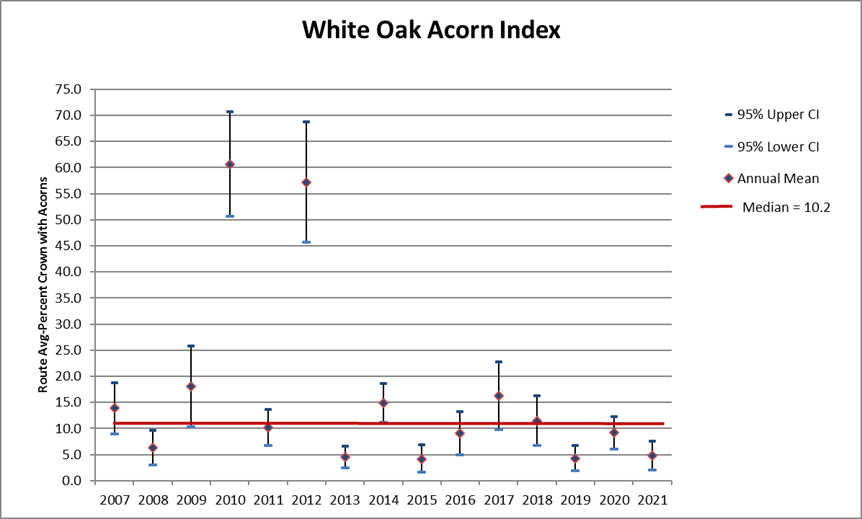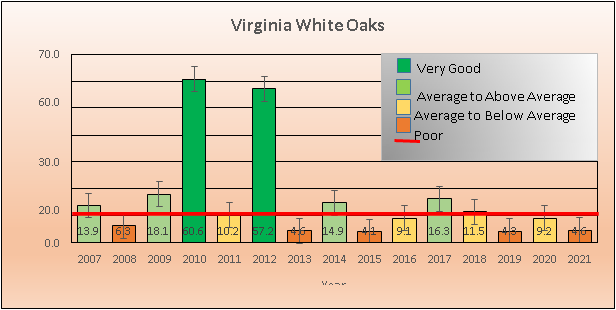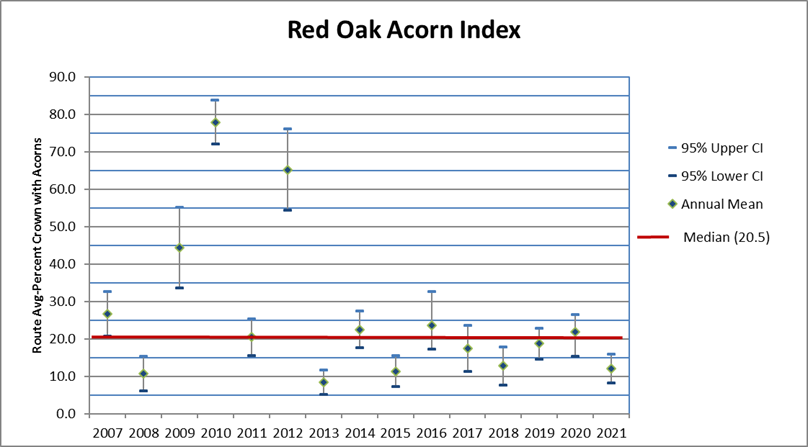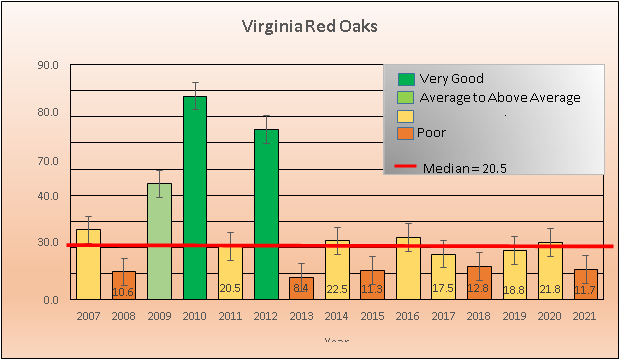
By Katie Martin, DWR Deer/Bear/Turkey Biologist
Photos by Lynda Richardson/DWR
More than 200,000 hunters will take to the woods this fall in search of deer, turkeys, and bears as well as a host of smaller game species. Hunters should know that acorns are a nutritious food providing protein, fat, and energy in the diets of 90 species of game and non-game animals in Virginia. Because acorns impact both wildlife and hunter success, the Department of Wildlife Resources (DWR) annually monitors acorn crops across the state.
Acorn production across the state in 2021 can be categorized overall as poor for both white and red oak species (Figures 1-4 below). Both white and red oaks fell well below the long term median over the 29 sites surveyed. On a positive note, most survey routes did have pockets of fair production and anecdotally reports of “bumper” mast crops have been reported across the state, thus emphasizing the variability of quality and production even within a single survey route.
Mid- to high-elevation sites generally had higher productivity this year, particularly for red oak species. While acorn production is variable from year to year for many reasons (weather, insects, tree species), for some of our survey sites we are probably approaching the biological end of production due to tree age. Unfortunately, finding “new” stands of mature oak in the 50-70 year age range is becoming more and more difficult due to aging forests and lack of sufficient regeneration. Replacing aging trees/survey sites could be quite a challenge moving forward.
Production by Region: White Oak
- Mountains: White oak production across most of the mountain region (16 survey sites) was extremely low. The North Mountain region averaged close to the long term median with better production seen at the higher elevation sites. Several southern mountain routes had pockets of fair production but were overall well below the median. Oak regeneration is a serious conservation issue in all of these areas and ongoing habitat management efforts have been underway by DWR and partner agencies to enhance areas with significant oak decline.
- Piedmont: White oak production across the Piedmont (10 sites) varied, but was highest in the Northern Piedmont with an average PCA (percent crowns with acorns) of 30% (above the long term median of 10.2%). The southern Piedmont flipped from 2020 when it was above average and came in well below the long term median in 2021. Anecdotal reports of bumper white oak trees (particularly in more urban areas) have been received from throughout the Piedmont. These may be worth looking into, especially during the archery season!
- Tidewater: The Tidewater area has our lowest sample size with three sites and unfortunately all three fell below the long term median in 2021. This was to be expected though after two out of the three sites experienced fairly high productivity in 2020. However, reports of soft mast species in this area (and across the entire state) were well above average, so keying in on persimmon, crab apple, and wild grapes could pay off in this area.
Production by Region: Red Oak
- Mountains: Red oak production was sporadic across the mountain region with pockets of average to above average production, particularly at high elevation sites. The southern mountain region had the highest average of trees with positive acorn production, with some individual sites being well above the long term median. Much like the white oak production this year, mid- to higher-elevation sites trended to better production.
- Piedmont: Red oak production was below the long term median in all three Piedmont zones Production across all sites trended lower than that found in the mountain region with very few reports of “bumper” crop trees.
- Tidewater: The Tidewater region averaged below the long term median, but did have 1 site (Big Woods WMA) with average red oak production. The other Tidewater sites did report a few pockets of “good to fair” production in slightly drier soils.
The annual hard mast survey has been an ongoing effort between the Virginia Department of Wildlife Resources and many partner agencies for many years. Many of the mountain survey sites have been in place since the 1950s. In 2021, staff from DWR, the U.S. Forest Service, U.S. Fish and Wildlife Service, the Virginia Department of Conservation and Recreation (DWR), Virginia Department of Forestry (DOF), U.S. Department of Defense/Department of Military Affairs, National Park Service, and Smithsonian Conservation Biology Institute surveyed 28 hard mast production sites across Virginia. Sites are located across all regions of the state, although a majority are currently found in the mountains. Continued efforts are being made to add sites to the Northern Piedmont and Tidewater areas.

Statewide white oak acorn production (average percent of tree crowns with acorns), presented as long term median (2007-2021) with 95% confidence

Figure 2: Statewide white oak acorn production (PCA) broken into categorical rankings based on 4 group cluster analysis with 95% confidence

Figure 3: Statewide red oak acorn production (average percent of tree crowns with acorns), presented as long term median (2007-2021) with 95% confidence

Figure 4: Statewide red oak acorn production (PCA) broken into categorical rankings based on 4 group cluster analysis with 95% confidence
Acorns are a staple food for Virginia’s wildlife, providing important resources to meet the physical challenges of winter weather and reproduction in the following spring. Wildlife need to move less when acorns are abundant, making game harder to find and leaving some hunters to wonder if game populations are lower. Under these conditions, hunter success rates decline. Conversely, when acorn crops fail, game search forests and fields more often for other food sources, which makes game easier for hunters to find and may increase a hunter’s odds of success.


